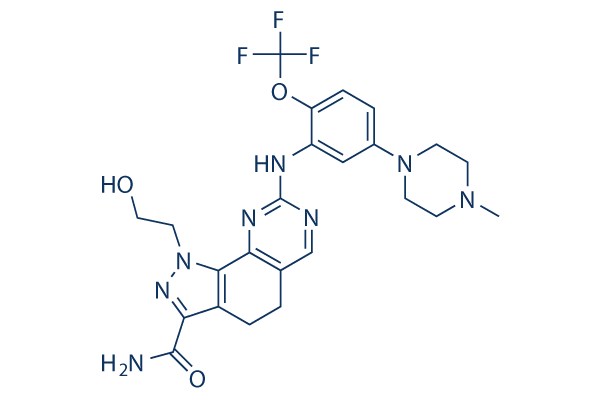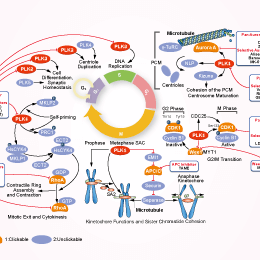
- Bioactive Compounds
- By Signaling Pathways
- PI3K/Akt/mTOR
- Epigenetics
- Methylation
- Immunology & Inflammation
- Protein Tyrosine Kinase
- Angiogenesis
- Apoptosis
- Autophagy
- ER stress & UPR
- JAK/STAT
- MAPK
- Cytoskeletal Signaling
- Cell Cycle
- TGF-beta/Smad
- DNA Damage/DNA Repair
- Compound Libraries
- Popular Compound Libraries
- Customize Library
- Clinical and FDA-approved Related
- Bioactive Compound Libraries
- Inhibitor Related
- Natural Product Related
- Metabolism Related
- Cell Death Related
- By Signaling Pathway
- By Disease
- Anti-infection and Antiviral Related
- Neuronal and Immunology Related
- Fragment and Covalent Related
- FDA-approved Drug Library
- FDA-approved & Passed Phase I Drug Library
- Preclinical/Clinical Compound Library
- Bioactive Compound Library-I
- Bioactive Compound Library-Ⅱ
- Kinase Inhibitor Library
- Express-Pick Library
- Natural Product Library
- Human Endogenous Metabolite Compound Library
- Alkaloid Compound LibraryNew
- Angiogenesis Related compound Library
- Anti-Aging Compound Library
- Anti-alzheimer Disease Compound Library
- Antibiotics compound Library
- Anti-cancer Compound Library
- Anti-cancer Compound Library-Ⅱ
- Anti-cancer Metabolism Compound Library
- Anti-Cardiovascular Disease Compound Library
- Anti-diabetic Compound Library
- Anti-infection Compound Library
- Antioxidant Compound Library
- Anti-parasitic Compound Library
- Antiviral Compound Library
- Apoptosis Compound Library
- Autophagy Compound Library
- Calcium Channel Blocker LibraryNew
- Cambridge Cancer Compound Library
- Carbohydrate Metabolism Compound LibraryNew
- Cell Cycle compound library
- CNS-Penetrant Compound Library
- Covalent Inhibitor Library
- Cytokine Inhibitor LibraryNew
- Cytoskeletal Signaling Pathway Compound Library
- DNA Damage/DNA Repair compound Library
- Drug-like Compound Library
- Endoplasmic Reticulum Stress Compound Library
- Epigenetics Compound Library
- Exosome Secretion Related Compound LibraryNew
- FDA-approved Anticancer Drug LibraryNew
- Ferroptosis Compound Library
- Flavonoid Compound Library
- Fragment Library
- Glutamine Metabolism Compound Library
- Glycolysis Compound Library
- GPCR Compound Library
- Gut Microbial Metabolite Library
- HIF-1 Signaling Pathway Compound Library
- Highly Selective Inhibitor Library
- Histone modification compound library
- HTS Library for Drug Discovery
- Human Hormone Related Compound LibraryNew
- Human Transcription Factor Compound LibraryNew
- Immunology/Inflammation Compound Library
- Inhibitor Library
- Ion Channel Ligand Library
- JAK/STAT compound library
- Lipid Metabolism Compound LibraryNew
- Macrocyclic Compound Library
- MAPK Inhibitor Library
- Medicine Food Homology Compound Library
- Metabolism Compound Library
- Methylation Compound Library
- Mouse Metabolite Compound LibraryNew
- Natural Organic Compound Library
- Neuronal Signaling Compound Library
- NF-κB Signaling Compound Library
- Nucleoside Analogue Library
- Obesity Compound Library
- Oxidative Stress Compound LibraryNew
- Plant Extract Library
- Phenotypic Screening Library
- PI3K/Akt Inhibitor Library
- Protease Inhibitor Library
- Protein-protein Interaction Inhibitor Library
- Pyroptosis Compound Library
- Small Molecule Immuno-Oncology Compound Library
- Mitochondria-Targeted Compound LibraryNew
- Stem Cell Differentiation Compound LibraryNew
- Stem Cell Signaling Compound Library
- Natural Phenol Compound LibraryNew
- Natural Terpenoid Compound LibraryNew
- TGF-beta/Smad compound library
- Traditional Chinese Medicine Library
- Tyrosine Kinase Inhibitor Library
- Ubiquitination Compound Library
-
Cherry Picking
You can personalize your library with chemicals from within Selleck's inventory. Build the right library for your research endeavors by choosing from compounds in all of our available libraries.
Please contact us at info@selleckchem.com to customize your library.
You could select:
- Antibodies
- Bioreagents
- qPCR
- 2x SYBR Green qPCR Master Mix
- 2x SYBR Green qPCR Master Mix(Low ROX)
- 2x SYBR Green qPCR Master Mix(High ROX)
- Protein Assay
- Protein A/G Magnetic Beads for IP
- Anti-Flag magnetic beads
- Anti-Flag Affinity Gel
- Anti-Myc magnetic beads
- Anti-HA magnetic beads
- Poly DYKDDDDK Tag Peptide lyophilized powder
- Protease Inhibitor Cocktail
- Protease Inhibitor Cocktail (EDTA-Free, 100X in DMSO)
- Phosphatase Inhibitor Cocktail (2 Tubes, 100X)
- Cell Biology
- Cell Counting Kit-8 (CCK-8)
- Animal Experiment
- Mouse Direct PCR Kit (For Genotyping)
- New Products
- Contact Us
research use only
Onvansertib (NMS-1286937, NMS-P937) PLK inhibitor
Onvansertib (NMS-1286937, NMS-P937) is an orally available, selective Polo-like Kinase 1 (PLK1) inhibitor with IC50 of 2 nM, 5000-fold selectivity over PLK2/PLK3. This compound potently causes a mitotic cell-cycle arrest followed by apoptosis in cancer cell lines and inhibits tumor growth. Phase 1.

Chemical Structure
Molecular Weight: 532.52
Purity & Quality Control
Batch:
Purity:
99.82%
99.82
Related Products
| Related Targets | PLK1 PLK2 PLK3 PLK4 | Click to Expand |
|---|---|---|
| Related Products | BI 2536 Volasertib (BI6727) Rigosertib (ON-01910) GSK461364 SBE 13 HCl Ro3280 CFI-400945 HMN-214 MLN0905 Poloxin | Click to Expand |
| Related Compound Libraries | Kinase Inhibitor Library PI3K/Akt Inhibitor Library MAPK Inhibitor Library DNA Damage/DNA Repair compound Library Cell Cycle compound library | Click to Expand |
Signaling Pathway
Cell Culture and Working Concentration
| Cell Lines | Assay Type | Concentration | Incubation Time | Formulation | Activity Description | PMID |
|---|---|---|---|---|---|---|
| A2780 | Antiproliferative assay | Antiproliferative activity against human A2780 cells, IC50 = 0.042 μM. | 21470862 | |||
| CAL51 | Cell cycle assay | 0.1 to 1 uM | 24 hrs | Cell cycle arrest in human CAL51 cells at 0.1 to 1 uM after 24 hrs by flow cytometry | 21470862 | |
| Click to View More Cell Line Experimental Data | ||||||
Mechanism of Action
| Targets |
|
|---|
In vitro |
||||
| In vitro | Onvansertib (NMS-1286937, NMS-P937) shows a broad-spectrum antiproliferative activity against different solid tumor, leukemias and lymphomas cell lines. It potently causes a mitotic cell-cycle arrest followed by apoptosis in A2780 cells. [2] |
|||
|---|---|---|---|---|
| Kinase Assay | Kinase profile | |||
| Onvansertib (NMS-1286937, NMS-P937) inhibitory activity and the potency of selected compounds are determined using a trans-phosphorylation assay. Specific peptide or protein substrates are trans-phosphorylated by their specific serine-threonine or tyrosine kinase, in the presence of ATP traced with 33P-γ-ATP, at optimized buffer and cofactors conditions. At the end of the phosphorylation reaction, more than 98% unlabeled ATP and radioactive ATP is captured by adding an excess of the ion exchange dowex resin; the resin then settles down to the bottom of the reaction plate by gravity. Supernatant, containing the phosphorylated substrate, is subsequently withdrawn and transferred into a counting plate, followed by evaluation by b-counting. Inhibitory potency evaluation for all the tested kinases was performed at 25 °C using a 60 min end-point assay where the concentrations of ATP and substrates are kept equal to 2 x αKm and saturated (>5 x αKm), respectively. | ||||
| Cell Research | Cell lines | 137 solid tumor cell lines, and 43 cell lines derived from leukemias and lymphomas | ||
| Concentrations | ~10 μM | |||
| Incubation Time | 72 hours | |||
| Method | Onvansertib (NMS-1286937, NMS-P937) was used to treat cells in duplicate with serial dilutions after they were seeded into 96- or 384-well plates at densities ranging from 10,000 to 30,000/cm2 for adherent and 100,000/mL for nonadherent cells in appropriate medium supplemented with 10% fetal calf serum for 24 hours. 72 hours later, the viable cell number was assessed by the CellTiter-Glo Assay (Promega). IC50 values were calculated with a sigmoidal fitting algorithm (Assay Explorer MDL). Experiments were carried out independently at least twice. |
|||
In Vivo |
||
| In vivo | Onvansertib (NMS-1286937, NMS-P937) shows significant tumor growth inhibition in mice xenografted with human HCT116 colon adenocarcinoma cells at a dose of 90 mg/kg/d i.v. or p.o. [1] In mice bearing HT29, Colo205 colorectal, or A2780 ovarian xenograft tumors, it inhibits xenograft tumor growth. In addition, this compound, in combination with approved cytotoxic drugs, causes enhanced tumor regression, and prolongs survival of animals. [2] |
|
|---|---|---|
| NCT Number | Recruitment | Conditions | Sponsor/Collaborators | Start Date | Phases |
|---|---|---|---|---|---|
| NCT05593328 | Active not recruiting | Colorectal Cancer|Metastatic Colorectal Cancer |
Cardiff Oncology |
March 17 2023 | Phase 2 |
| NCT03829410 | Completed | Metastatic Colorectal Cancer|KRAS Gene Mutation |
Cardiff Oncology |
May 6 2019 | Phase 1|Phase 2 |
| NCT03303339 | Completed | Acute Myeloid Leukemia |
Cardiff Oncology |
November 17 2017 | Phase 1|Phase 2 |
References |
|
Chemical Information
| Molecular Weight | 532.52 | Formula | C24H27F3N8O3 |
| CAS No. | 1034616-18-6 | SDF | Download SDF |
| Synonyms | PCM-075, NMS1286937 | ||
| Smiles | CN1CCN(CC1)C2=CC(=C(C=C2)OC(F)(F)F)NC3=NC=C4CCC5=C(C4=N3)N(N=C5C(=O)N)CCO | ||
Storage and Stability
| Storage (From the date of receipt) | |||
|
In vitro |
DMSO : 50 mg/mL ( (93.89 mM) Moisture-absorbing DMSO reduces solubility. Please use fresh DMSO.) Ethanol : 2 mg/mL Water : Insoluble |
Molecular Weight Calculator |
|
In vivo Add solvents to the product individually and in order. |
In vivo Formulation Calculator |
|||||
Preparing Stock Solutions
Molarity Calculator
In vivo Formulation Calculator (Clear solution)
Step 1: Enter information below (Recommended: An additional animal making an allowance for loss during the experiment)
mg/kg
g
μL
Step 2: Enter the in vivo formulation (This is only the calculator, not formulation. Please contact us first if there is no in vivo formulation at the solubility Section.)
% DMSO
%
% Tween 80
% ddH2O
%DMSO
%
Calculation results:
Working concentration: mg/ml;
Method for preparing DMSO master liquid: mg drug pre-dissolved in μL DMSO ( Master liquid concentration mg/mL, Please contact us first if the concentration exceeds the DMSO solubility of the batch of drug. )
Method for preparing in vivo formulation: Take μL DMSO master liquid, next addμL PEG300, mix and clarify, next addμL Tween 80, mix and clarify, next add μL ddH2O, mix and clarify.
Method for preparing in vivo formulation: Take μL DMSO master liquid, next add μL Corn oil, mix and clarify.
Note: 1. Please make sure the liquid is clear before adding the next solvent.
2. Be sure to add the solvent(s) in order. You must ensure that the solution obtained, in the previous addition, is a clear solution before proceeding to add the next solvent. Physical methods such
as vortex, ultrasound or hot water bath can be used to aid dissolving.
Tech Support
Answers to questions you may have can be found in the inhibitor handling instructions. Topics include how to prepare stock solutions, how to store inhibitors, and issues that need special attention for cell-based assays and animal experiments.
Tel: +1-832-582-8158 Ext:3
If you have any other enquiries, please leave a message.
* Indicates a Required Field






































